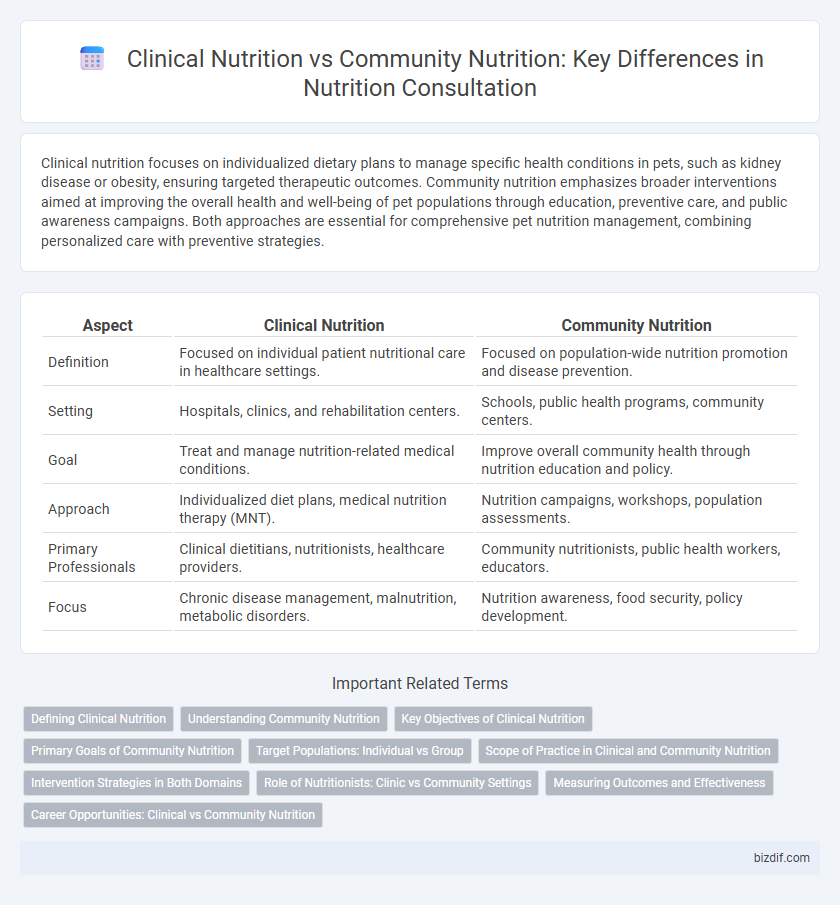Clinical nutrition focuses on individualized dietary plans to manage specific health conditions in pets, such as kidney disease or obesity, ensuring targeted therapeutic outcomes. Community nutrition emphasizes broader interventions aimed at improving the overall health and well-being of pet populations through education, preventive care, and public awareness campaigns. Both approaches are essential for comprehensive pet nutrition management, combining personalized care with preventive strategies.
Table of Comparison
| Aspect | Clinical Nutrition | Community Nutrition |
|---|---|---|
| Definition | Focused on individual patient nutritional care in healthcare settings. | Focused on population-wide nutrition promotion and disease prevention. |
| Setting | Hospitals, clinics, and rehabilitation centers. | Schools, public health programs, community centers. |
| Goal | Treat and manage nutrition-related medical conditions. | Improve overall community health through nutrition education and policy. |
| Approach | Individualized diet plans, medical nutrition therapy (MNT). | Nutrition campaigns, workshops, population assessments. |
| Primary Professionals | Clinical dietitians, nutritionists, healthcare providers. | Community nutritionists, public health workers, educators. |
| Focus | Chronic disease management, malnutrition, metabolic disorders. | Nutrition awareness, food security, policy development. |
Defining Clinical Nutrition
Clinical nutrition involves the assessment and management of patients' dietary needs within healthcare settings to support disease treatment and recovery. It focuses on personalized nutrition therapy for conditions such as diabetes, cardiovascular diseases, and malnutrition. This specialized practice contrasts with community nutrition, which emphasizes population-based nutrition programs and public health interventions.
Understanding Community Nutrition
Community nutrition emphasizes promoting health and preventing disease through nutrition education, policy development, and program implementation within diverse populations. It targets groups by addressing socioeconomic, cultural, and environmental factors influencing dietary behaviors and nutritional status. Clinical nutrition primarily focuses on individualized dietary management for patients with specific health conditions in healthcare settings.
Key Objectives of Clinical Nutrition
Clinical Nutrition primarily focuses on individualized patient care, aiming to diagnose and manage nutritional deficiencies and diet-related diseases through tailored dietary interventions. Its key objectives include optimizing nutrient intake to promote recovery, supporting disease treatment, and preventing complications in clinical settings such as hospitals and outpatient clinics. This specialized approach contrasts with Community Nutrition, which emphasizes population-wide nutritional well-being and education.
Primary Goals of Community Nutrition
Community nutrition focuses on improving the overall health of populations through preventive measures, nutrition education, and policy development aimed at reducing nutrition-related diseases. It emphasizes accessibility to healthy foods, promoting sustainable dietary habits, and addressing social determinants of health in diverse communities. Unlike clinical nutrition, which centers on individualized medical nutrition therapy for patients, community nutrition targets widespread public health interventions to enhance population well-being.
Target Populations: Individual vs Group
Clinical nutrition targets individual patients with personalized dietary plans to manage specific health conditions such as diabetes, kidney disease, or malnutrition. Community nutrition focuses on groups and populations, aiming to improve public health through nutrition education, policy development, and preventive programs tailored to diverse demographic needs. Both approaches optimize nutritional outcomes but differ in scale, with clinical nutrition offering customized care and community nutrition addressing broader social determinants of health.
Scope of Practice in Clinical and Community Nutrition
Clinical nutrition focuses on individualized medical nutrition therapy, addressing specific diseases and metabolic conditions within healthcare settings such as hospitals and clinics. Community nutrition emphasizes population-based strategies to promote nutritional health, prioritize disease prevention, and improve public well-being across diverse groups in schools, workplaces, and public health programs. The scope of practice in clinical nutrition involves assessment, diagnosis, and treatment of nutrition-related illnesses, while community nutrition professionals design and implement nutrition education and policy initiatives targeting broader populations.
Intervention Strategies in Both Domains
Clinical nutrition intervention strategies focus on personalized dietary plans tailored to individual medical conditions, utilizing medical nutrition therapy to manage diseases such as diabetes, cardiovascular disorders, and malnutrition. Community nutrition employs population-based approaches like nutrition education programs, policy advocacy, and food access initiatives to improve overall public health and prevent nutrition-related diseases. Both domains emphasize evidence-based practices, yet clinical nutrition addresses specific patient needs while community nutrition targets broader social determinants of health.
Role of Nutritionists: Clinic vs Community Settings
Nutritionists in clinical settings assess individual patient needs to develop personalized medical nutrition therapy plans targeting specific health conditions such as diabetes or cardiovascular disease. In community settings, nutritionists design and implement public health programs aimed at improving nutritional status and preventing chronic diseases across diverse populations. Their role involves education, policy advocacy, and collaboration with local organizations to address broader social determinants of health.
Measuring Outcomes and Effectiveness
Clinical nutrition emphasizes individualized patient assessments using biochemical markers and clinical parameters to measure outcomes and effectiveness. Community nutrition evaluates population-level health indicators, such as morbidity rates and dietary behavior changes, to determine intervention success. Both approaches utilize data-driven metrics but differ in scale and focus, with clinical nutrition targeting patient-specific improvements and community nutrition addressing broader public health goals.
Career Opportunities: Clinical vs Community Nutrition
Career opportunities in clinical nutrition primarily involve working in hospitals, outpatient clinics, and long-term care facilities, focusing on patient-centered care and medical nutrition therapy. In contrast, community nutrition professionals engage in public health programs, schools, and non-profits, emphasizing disease prevention and health promotion at the population level. Both fields demand expertise in dietary assessment and intervention but diverge in their target settings and impact scope.
Clinical Nutrition vs Community Nutrition Infographic

 bizdif.com
bizdif.com